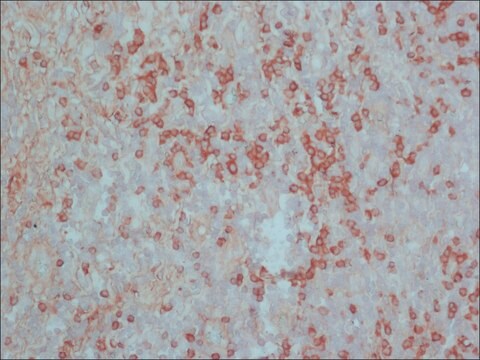AP183F
Goat Anti-Rat IgG Antibody, FITC conjugate, Species Adsorbed
Chemicon®, from goat
Sign Into View Organizational & Contract Pricing
All Photos(1)
About This Item
UNSPSC Code:
12352203
eCl@ss:
32160702
NACRES:
NA.46
Recommended Products
biological source
goat
Quality Level
conjugate
FITC conjugate
antibody form
F(ab′)2 fragment of affinity isolated antibody
antibody product type
secondary antibodies
clone
polyclonal
species reactivity
rat
manufacturer/tradename
Chemicon®
technique(s)
immunofluorescence: suitable
shipped in
wet ice
target post-translational modification
unmodified
Related Categories
Application
Research Category
Secondary & Control Antibodies
Secondary & Control Antibodies
Research Sub Category
Secondary Antibodies Adsorbed for Dual Labeling
Secondary Antibodies Adsorbed for Dual Labeling
This Goat anti-Rat IgG Antibody, FITC conjugate, Species Adsorbed is validated for use in IF for the detection of Rat IgG.
Legal Information
CHEMICON is a registered trademark of Merck KGaA, Darmstadt, Germany
Disclaimer
Unless otherwise stated in our catalog or other company documentation accompanying the product(s), our products are intended for research use only and are not to be used for any other purpose, which includes but is not limited to, unauthorized commercial uses, in vitro diagnostic uses, ex vivo or in vivo therapeutic uses or any type of consumption or application to humans or animals.
Not finding the right product?
Try our Product Selector Tool.
Hazard Statements
Precautionary Statements
Hazard Classifications
Aquatic Chronic 3
Storage Class Code
11 - Combustible Solids
WGK
WGK 3
Certificates of Analysis (COA)
Search for Certificates of Analysis (COA) by entering the products Lot/Batch Number. Lot and Batch Numbers can be found on a product’s label following the words ‘Lot’ or ‘Batch’.
Already Own This Product?
Find documentation for the products that you have recently purchased in the Document Library.
Generation of reelin-positive marginal zone cells from the caudomedial wall of telencephalic vesicles.
Takiguchi-Hayashi, K; Sekiguchi, M; Ashigaki, S; Takamatsu, M; Hasegawa et al.
The Journal of Neuroscience null
R Arai et al.
Brain research, 706(1), 177-179 (1996-01-08)
The aim of the present study is to examine whether serotonergic fibers of the striatum of the rat contain aromatic L-amino acid decarboxylase (AADC). By use of a double-labeling immunofluorescence method, we showed that AADC was localized in serotonergic fibers
T Ito et al.
Histochemistry and cell biology, 104(5), 357-362 (1995-11-01)
Pulmonary endocrine cells of Syrian golden hamster were stained for neural cell adhesion molecule (NCAM) with indirect fluorescent immunostaining and observed with a confocal laser scanning microscope equipped with an argon laser. Sections 100 microns thick of hamster lung fixed
R Arai et al.
Neuroscience, 114(4), 825-835 (2002-10-16)
Monoamine oxidase type A and type B are major neurotransmitter-degrading enzymes in the CNS. The type A is present on mitochondrial outer membranes in the whole extent of noradrenergic and dopaminergic neurons, including their axon terminals. The type B is
Aakash Koppula et al.
Cancers, 14(2) (2022-01-22)
Circular RNAs (circRNAs) are regulatory RNAs which have recently been shown to have clinical significance in several diseases, including, but not limited to, various cancers, neurological diseases and cardiovascular diseases. The function of such regulatory RNAs is largely dependent on
Our team of scientists has experience in all areas of research including Life Science, Material Science, Chemical Synthesis, Chromatography, Analytical and many others.
Contact Technical Service








